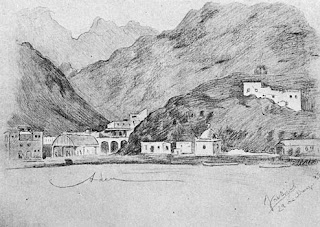 |
| José Rizal's pen & ink sketch of Aden, Yemen, 28 May,1882 |
In 1882, Jose Rizal was on his way to Spain. It was his first trip abroad, and being such a keen and interested observer, he brought his sketch book along and made pen and ink sketches of most ports his ship visited.
What caught my attention is José Rizal's sketch of Aden, Yemen. Today, Yemen is currently in turmoil and is presently in our daily world news headlines due of the demonstrations sweeping the Middle East. In 1992, the USS Cole was bombed in Aden by Al Qaeda terrorists. This week, Yemen's president, Saleh, is under pressure for reform though people power.
The port of Aden, Yemen is important for the US Navy fleet. It was an important port of call in the 1880's. Steamers coming from Asia load coal from this port before proceeding on to the Suez Canal on the way to Europe.
In Rizal's letter to his family he notes the heat: "The ground, like the sun, is hot and hard, the wind, loaded with burning sand, disturbs now and then the quietness of its well made and deserted streets."
He said that only men can live there because "everywhere else is death, neither a root nor a leaf" can exist in Aden's environment.
Note how Rizal shows the attributes of a great writer. He doesn't tell us directly that the land is a desert. He shows us with metaphors and descriptions. Rizal described the landscape thus: "...limp and rickety trees...there's nothing but complete aridity...." He went to the bazaar and noted the displayed goods: "skins of lion, tiger, panther, and leopard, ostrich eggs and feathers...."
What intrigued Rizal was the method and special effect of conserving the water in such a dry place: "There are the cisterns or reservoirs. These are some large cavities, whitened with stucco formed by the mountain and a wall which, with the rock, form a receptacle." He was astounded by its size comparing the length to five times the size of a dam "like that we have there." He depicted the huge reservoir in his sketch.
In the course of a brief stop over in Aden, Yemen, Rizal was able to study the topography of the bay; he likened it to a tunnel. The surrounding mountains, he deftly sketched in soft black and white shades.
